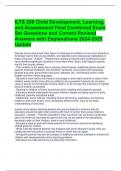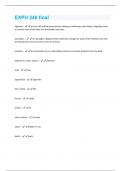ILTS 206 Child Development, Learning,
and Assessment Final Combined Exam
Set Questions and Correct Revised
Answers with Explanations 2024-2025
Update
Discuss some cultural and other types of influences on whether or how much parents in
American read to their young children, and describe some educational implications of
these influences - Answer- - Researchers analyzing national early childhood surveys
have identified significant variations in how often white, Asian, and Hispanic parents
read to their young children
- This variation is not solely due to varying cultural values. Additional factors include
parents' financial limitations, time limitation, familiarity, and comfort with accessing
libraries and other government resources, websites, etc., and literacy levels in both
English and their native languages
- Educators must realize that trying to encourage or even teach parents to read to their
children earlier and/or more often is unlikely to be successful if parents do not place
value or priority on the benefits of being read to, or do not view the outcomes of reading
aloud to children as benefits
- Reading to children is known to promote school reading and academic success
- Educators should understand that some children, despite not being read to in early
childhood, become successful adults
- Additionally, some cultures, including African Americans, emphasize oral learning
traditions more than written ones, developing different skills, such as the basic
understanding of story flow
Explain some factors affecting parents who are immigrants to America that EC
educators should consider when working with them to further their young children's
education - Answer- - Parents educated in other countries may not know a great deal
about the American educational system and may not be aware of the educational
demands made on their children, even in early childhood
- Educators need to work with these parents to find common ground by identifying
shared goals for children
- While culturally diverse parents may disagree with some educator's goals, they can
collaborate with educators to promote those on which they do agree
- Immigrant parents may also be unaware of additional services available in America for
children with developmental and/or learning problems
- Educators can help parents by providing this information
,- Another consideration is that some other cultures have more paternalistic educational
systems. Parents from such cultures, rather than vocally advocating for their children
who need services, tend to wait for teachers/specialists to voice concerns before
communicating and problems they have observed
- Thus, they could miss out on the chance to obtain helpful services. Even worse,
educators could misconstrue their behavior as a lack of interest in children's progress,
or as resistance to confronting problems
Give some examples of EC developmental milestones and their associated ages that
vary according to culture, using one example to explain how this variation affects
expectations of "normal" development - Answer- - Research has found that different
cultures have different age expectations for many early childhood developmental
milestones
- Filipinos expect children to eat using utensils at 32.4 months. Anglo families expect
children to do this at 17.7 months, and Puerto Ricans expect children to reach this
milestone at 26.5 months.
- Filipino cultures expect children to sleep all night by 32.4 months, Puerto Rican and
Anglo cultures expect this at 14.5 and 14.4 months, respectively
- While Anglos expect children to sleep by themselves at around 13.8 months and
Puerto Ricans at around 14.6 months, Filipinos do not expect this until 38.8 months
- Filipinos expect children to eat solid food by 6.7 months, Anglos by 8.2 months, and
Puerto Ricans by 10.1 months
- In Anglo families, an 18-month-old not drinking from a cup could indicate
developmental delay if parents introduced the cup when the child was one year old and
regularly continued encouraging cup use. But, Filipino parents of an 18-month-old have
likely not even introduced the child to a cup yet, so the fact that the child is not using a
cup would not be cause for concern from a development standpoint
List a number of early developmental milestones that have varying age expectations
among different cultural groups - Answer- - Eating solid food
- Weaning from nursing
- Drinking from a cup
- Eating with the fingers
- Eating with utensils
- Sleeping along
- Sleeping through the night
- Choosing one's own clothes
- Dressing oneself
- Playing alone
- Daytime and nighttime toilet training
Explain some implications of these variations for EC educators and for developmental
assessments - Answer- - Educators must become aware of different cultures' different
socialization goals before assuming culturally diverse children have developmental
delays
,- On the other hand, they must also avoid automatically attributing variations in
milestone achievement to cultural child-rearing differences when full developmental
assessments might be indicated
- Family expectations and values influence the complex process of developmental
assessment
- When families and assessors share common cultures, it is more likely that valid data
will be collected and interpreted
- When their cultures differ, it is more likely that the assessment information will be
misinterpreted
- Employing early childhood teacher/care providers who are familiar with the child,
family, and assessment setting as mediators can make developmental assessments
more culturally competent
Identify 10 concepts considered essential in geography. Define and give examples of
the first three - Answer- - Location identifies where a place is and examines the positive
and negative properties of any place on the surface of the Earth. Absolute location is
based upon latitude and longitude. Relative location is based upon changing
characteristics of a region and is influenced by surrounding areas. For example, urban
areas have higher land prices than rural ones
- Distance identifies how far a place is and is often described in terms of location. It is
also related to the effort required to meet basic life needs. For example, the distance of
raw materials from factories affects transportation costs and hence production prices. In
another example, land costs less the farther it is from highways
- Achievability identifies how accessible a geographical area is based on the conditions
on the Earth's surface. For example, villages on beaches are easier to reach. Villages
surrounded by forests or swamps are harder to reach. As its economy, science,
technology, and transportation develop, a region's level of dependency on other areas
changes
Identify ten concepts considered essential to the study of geography. Define and give
examples of four through seven - Answer- - Patterns are found in geographical forms
and in how geographical phenomena spread, which affects dependency on those
phenomena. For example, in fold regions, the rivers typically form trellis patterns.
Patterns are also seen in human activity that is based on geography. For example, in
mountainous regions, settlements predominately form spreading patterns
- Morphology is the shape of our planet's surface resulting from inner and outer forces.
For example, along the northern coast of Java, sugarcane plantations predominate in
the lowlands
- Agglomeration is defined as collecting into a mass and refers to a geographic
concentration of people, activities, and/or settlements within areas that are most
profitable and relatively narrow in size
- Utility value refers to the existence and relative usefulness of natural resources. For
example, fishermen find more utility value in the ocean than farmers do, and naturalists
perceive more utility value in forests than academics would
, Identify 10 concepts considered essential to the study of geography. Define and give
examples of the final three - Answer- - interaction is the reciprocal and interdependent
relationship between two or more geographical areas, which can generate new
geographical phenomena, configurations, and problems. For example, a rural village
produces raw materials through activities like mining ores or growing and harvesting
plant crops, while a city produces industrial goods. The village needs a city as a market
for its raw materials and may also need the city's industrial products. The city needs the
village for its raw materials to use in industrial production. This interdependence causes
interaction
- area differentiation informs the study of variations among regional geographical
phenomena. For example, different plans are cultivated in Highlands versus lowlands
due to their different altitudes and climates. Area differentiation also informs the study of
regional variations in occupation
- spatial interrelatedness shows the relationship between and among geographic and
non-physical phenomena, like rural and urban areas. The example above of village city
interaction also applies here
Identify two general categories of features that can be displayed on maps, and include
some examples in your response - Answer- - maps can be drawn to show natural or
man-made features. For example, some maps make mountains, elevations, average
rainfall, average temperatures, and other natural features of an area
- other maps are made to depict countries, states, cities, roads, empires, wars, and
other man made features
identify three different purposes for which maps are used - Answer- - different types of
maps are described according to their purposes
- political maps are made to debate countries, areas within a country, or cities
- physical maps are drawn to display natural features of the terrain in an area, such as
rivers, lakes, and mountains
- thematic maps are drawn to focus on a more specific theme or topic, such as the
locations and names of battles during the war or the average amounts of rainfall a
country, state, or region receives in a given year or month
- some maps are made for more than one purpose and indicate more than one of the
types of information described above
Describe some basic tools that cartographers supply on maps, the information they
provide, and how to use them - Answer- - on maps depicting local, national, and world
geography, cartographers supply tools for navigating these maps
- the compass rose indicates the directions of north, S, east, and West. By looking at
the compass, people can identify the locational relationships of places
- the scale of miles indicates how distances on a map correspond to actual geographical
distances, enabling us to estimate real distances. For example, the scale might show
that one inch is equal to 500 miles. By placing a piece of paper on the map we can mark
it to measure the distance between two cities on the map, and then line the paper up
with the scale miles to estimate an actual distance of approximately 650 miles between
the two cities






